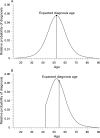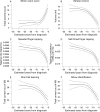Detection of Huntington's disease decades before diagnosis: the Predict-HD study
- PMID: 18096682
- PMCID: PMC2569211
- DOI: 10.1136/jnnp.2007.128728
Detection of Huntington's disease decades before diagnosis: the Predict-HD study
Abstract
Objective: The objective of the Predict-HD study is to use genetic, neurobiological and refined clinical markers to understand the early progression of Huntington's disease (HD), prior to the point of traditional diagnosis, in persons with a known gene mutation. Here we estimate the approximate onset and initial course of various measurable aspects of HD relative to the time of eventual diagnosis.
Methods: We studied 438 participants who were positive for the HD gene mutation, but did not yet meet the diagnostic criteria for HD and had no functional decline. Predictability of baseline cognitive, motor, psychiatric and imaging measures was modelled non-linearly using estimated time until diagnosis (based on CAG repeat length and current age) as the predictor.
Results: Estimated time to diagnosis was related to most clinical and neuroimaging markers. The patterns of association suggested the commencement of detectable changes one to two decades prior to the predicted time of clinical diagnosis. The patterns were highly robust and consistent, despite the varied types of markers and diverse measurement methodologies.
Conclusions: These findings from the Predict-HD study suggest the approximate time scale of measurable disease development, and suggest candidate disease markers for use in preventive HD trials.
Conflict of interest statement
Figures



References
-
- Gusella JF, MacDonald ME. Huntington’s disease: CAG genetics expands neurobiology. Curr Opin Neurobiol 1995;5:656–62 - PubMed
-
- Paulson HL, Fischbeck KH. Trinucleotide repeats in neurogenetic disorders. Annu Rev Neurosci 1996;19:79–107 - PubMed
-
- Langbehn DR, Brinkman R, Faulush D, et al. A new model for prediction of the age of onset and penetrance for Huntington’s disease based on CAG length. Clin Genet 2004;65:267–77 - PubMed
-
- Penney JB, Jr, Young AB, Shoulson I, et al. Huntington’s disease in Venezuela: 7 years of follow-up on symptomatic and asymptomatic individuals. Mov Disord 1990;5:93–9 - PubMed
-
- Siemers E, Foroud T, Bill DJ, et al. Motor changes in presymptomatic Huntington disease gene carriers. Arch Neurol 1996;53:487–92 - PubMed
Publication types
MeSH terms
Substances
Grants and funding
LinkOut - more resources
Full Text Sources
Other Literature Sources
Medical
Molecular Biology Databases
